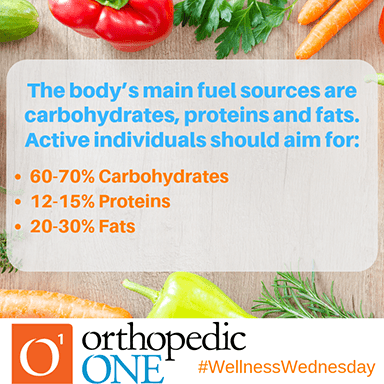Nutrition for the Active Individual: You Get Out What You Put In
Nutrition is an important aspect of healthy living that even those who consider themselves to be active, can tend to overlook. There is a false belief that logging enough hours of physical activity is the main factor in getting to and maintaining a healthy weight. Worse, some are under the impression that consistent exercise serves as a free pass to over-indulge during meal and snack times. However, weight loss and maintenance is more about what goes into the body than what is burned off, with the ratio being around 20% dependent on exercise vs. 80% dependent on nutrition.
Additionally, the energy needed to keep up with a high level of physical activity begins with how the body is fueled. In order for performance levels to remain high, energy levels, which stem from proper nutrition, must also remain high. Sustaining proper energy levels will not only positively impact performance, but will also help aid in injury prevention.

It’s important to understand that what a person has consumed in the last 24 hours is not the only factor that will determine their physical state. How the body has been fueled over the course of the last several days plays a major role in determining how it will react at certain activity levels.
The body’s main fuel sources include carbohydrates, proteins and fats. Carbohydrates should make up about 60-70% of an active individual’s daily calorie intake. Some examples of foods that provide a good source of carbohydrates include fruits, vegetables, rice and cereal. Carbohydrates are important, as they are converted into the energy needed for physical activity. If the body does not have the proper amount of carbohydrates, it will start burning energy from proteins and fats, causing an increase in fatigue and a drop in performance levels. Here are some tips to maintain carbohydrate fuel:
- Consume carbohydrates for several days consecutively, especially before a big event.
- Consume additional carbohydrates in preparation for physical activity that lasts more than one hour at a time.
Proteins should make up about 12-15% of an active individual’s daily calories. Meat, eggs, nuts and dairy products are all good sources of protein. The amount of protein a person should aim to consume varies based on the following factors:
- Level of fitness
- Exercise type
- Exercise intensity
- Exercise duration
- Carbohydrate intake
- Total daily calories consumed
The human body does not have the ability to store extra protein, so it is either burned for energy or converted into fat. Fats should make up about 20-30% of daily consumed calories. There are two different types of fats: saturated and unsaturated. Saturated fats are fats that come from animal-based foods like meat, eggs and some dairy products. Unsaturated fats are fats found in vegetable products, such as corn oil. The body only needs a small amount of fat, as too much can lead to health problems. Fat can be converted to energy, but this is dependent on the intensity and duration of a person’s physical activity. Low to moderate intensities use fat as the primary fuel source, while high intensity activities are mainly sourced by carbohydrates.
While what a person eats is very important to their physical performance and overall health, water is the most important nutrient for any active individual. In fact, the human body is composed of roughly 60% water. Therefore it is vital to replace water lost through urine and sweat, as the body cannot produce or store water.
The average person should consume 2 quarts or 64 ounces of water per day and those who are active should drink even more. Hydration is especially important in hot and humid weather, when sweat production increases. Follow these tips to achieve optimum hydration levels:
- Drink small amounts of water more frequently versus large amounts less frequently.
- Drink cold beverages to keep your core temperature cool.
- Track your sweat! For every pound of sweat, drink 16-24 ounces of water to replace it.
- Make note of the amount and color of your urine. A large amount of clear urine is ideal.
Sources: American Academy of Orthopaedic Surgeons and National Center for Biotechnology Information, U.S. National Library of Medicine